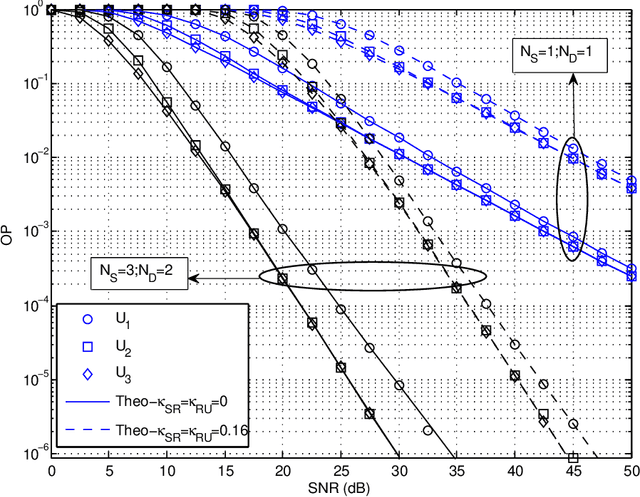Oguz Kucur
Quasisynchronous LoRa for LEO Nanosatellite Communications
Aug 01, 2023Abstract:Perfect synchronization in LoRa communications between Low Earth Orbit (LEO) satellites and ground base stations is still challenging, despite the potential use of atomic clocks in LEO satellites, which offer high precision. Even by incorporating atomic clocks in LEO satellites, their inherent precision can be leveraged to enhance the overall synchronization process, perfect synchronization is infeasible due to a combination of factors such as signal propagation delay, Doppler effects, clock drift and atmospheric effects. These challenges require the development of advanced synchronization techniques and algorithms to mitigate their effects and ensure reliable communication from / to LEO satellites. However, maintaining acceptable levels of synchronization rather than striving for perfection, quasisynchronous (QS) communication can be adopted which maintains communication reliability, improves resource utilization, reduces power consumption, and ensures scalability as more devices join the communication. Overall, QS communication offers a practical, adaptive, and robust solution that enables LEO satellite communications to support the growing demands of IoT applications and global connectivity. In our investigation, we explore different chip waveforms such as rectangular and raised cosine. Furthermore, for the first time, we study the Symbol Error Rate (SER) performance of QS LoRa communication, for different spreading factors (SF), over Additive White Gaussian Noise (AWGN) channels.
An Experimental Study of NOMA for Connected Autonomous Vehicles
Apr 03, 2023Abstract:Connected autonomous vehicles (CAV) constitute an important application of future-oriented traffic management .A vehicular system dominated by fully autonomous vehicles requires a robust and efficient vehicle-to-everything (V2X) infrastructure that will provide sturdy connection of vehicles in both short and long distances for a large number of devices, requiring high spectral efficiency (SE). Power domain non-orthogonal multiple access (PD-NOMA) technique has the potential to provide the required high SE levels. In this paper, a vehicular PD-NOMA testbed is implemented using software defined radio (SDR) nodes. The main concerns and their corresponding solutions arising from the implementation are highlighted. The bit error rates(BER) of vehicles with different channel conditions are measured for mobile and stationary cases. The extent of the estimation errors on the success rate beyond the idealized theoretical analysis view is investigated and the approaches to alleviate these errors are discussed. Finally, our perspective on possible PD-NOMA based CAV deployment scenarios is presented in terms of performance constraints and expectancy along with the overlooked open issues.
Performance Analyses of TAS/Alamouti-MRC NOMA in Dual-Hop Full-Duplex AF Relaying Networks
Sep 25, 2021



Abstract:In this paper, the performance of a power domain downlink multiple-input multiple-output non-orthogonal multiple access system in dual-hop full-duplex (FD) relaying networks is investigated over Nakagami-$m$ fading channels by considering the channel estimation error and feedback delay. Particularly, in the investigated system, the base station equipped with multiple antennas transmits information to all mobile users by applying conventional transmit antenna selection/Alamouti-space-time block coding scheme with the help of a dedicated FD amplify-and-forward relay. The received signals at mobile users are combined according to maximal-ratio combining technique to exploit benefits of receive diversity. In order to demonstrate the superiority of the proposed system, outage probability (OP) is investigated and tight lower bound expressions are derived for the obtained OP. Moreover, asymptotic analyses are also conducted for ideal and practical conditions to provide further insights about the outage behavior in the high signal-to-noise ratio region. Finally, theoretical analyses are validated via Monte Carlo simulations and software defined radio based test-bed implementation.
Performance Analyses of MRT/MRC in Dual-Hop NOMA Full-Duplex AF Relay Networks with Residual Hardware Impairments
Feb 16, 2021



Abstract:This paper analyzes the performance of maximum-ratio transmission (MRT)/maximum-ratio combining (MRC) scheme in a dual-hop non-orthogonal multiple access (NOMA) full-duplex (FD) relay networks in the presence of residual hardware impairments (RHIs). The effects of channel estimation errors (CEEs) and imperfect successive interference cancellation are also considered for a realistic performance analysis. In the network, the base station and multiple users utilize MRT and MRC, respectively, while a dedicated relay consisting of two antennas, one for receiving and the other for broadcasting, operates in amplify-and-forward mode. For performance criterion, exact outage probability (OP) expression is derived for Nakagami-m fading channels. Furthermore, a tight lower bound and asymptotic expressions are also derived to provide more insights into the obtained OP in terms of diversity order and array gain. The obtained numerical results demonstrate the importance of loop-interference cancellation process at FD relay in order for the investigated system to perform better than half-duplex-NOMA counterpart. Also, a performance trade-off between the MRT and MRC schemes is observed in the presence of CEEs among users. Furthermore, it is shown that RHIs have a significant effect on the performance of users with lower power coefficients, however it does not change the diversity order. RHIs and CEEs have the most and least deterioration effects on the system performance, respectively.
 Add to Chrome
Add to Chrome Add to Firefox
Add to Firefox Add to Edge
Add to Edge